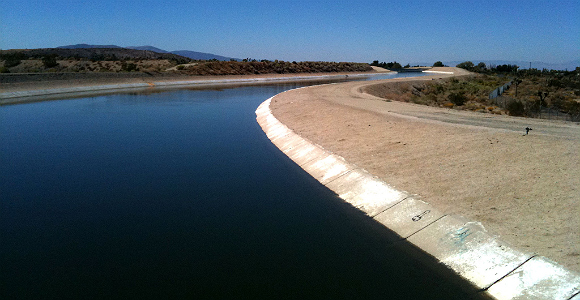
California aqueduct. (Photo Credit: Marianne Muegenburg Cothern/Flickr)
It’s less than two weeks from the election and neither the drought nor support for the state water bond seem to be waning much. And most people immersed in the sometimes-heated water issue in California would agree that the drought and the huge need for smart, long-term water funding aren’t going away very soon.
In PPIC’s monthly poll of Californians released last night, 56 percent of likely voters said they would vote yes on the Proposition 1 water bond, while 32 percent would vote no.
Not surprisingly, 66 percent of Central Valley likely voters, living in the biggest agricultural region in the U.S., said the outcome of the water bond vote was “Very Important.” The drought even prompted an annual corn maze in the region to be downsized and become drought-themed.
Also not surprisingly, those surveyed (all adults) once again placed the drought/water issue in a close second (26 percent) to “jobs and the economy” (29 percent) as the top issues the state faces.
While the drought is reminding people of the importance of water to the economy, it also reinforces the idea that states and regions making long-term investments in infrastructure will win the 21st century while others might just circle the drain.
Gov. Brown, seeking his fourth term, said earlier this week at a Stanford water summit that California water is the work of a four-term governor in a very long game.
“The first couple of terms to set the table and make the proposals, and then the last two terms 30 years later to finally carry the ball across the finish line,” said Brown talking about new groundwater management legislation.
While we may not see another governor returning after a 30-year hiatus to finish up some business, the state has the Prop 1 water bond on the table, if approved, bringing $7.5 billion to projects until 2022.
Our analysis from right after the bond deal was struck shows the bond is relatively low on pork, unlike past bonds and contains little connection to the controversial Delta tunnel project.
An important priority for the Economic Summit, the bond does include around $1 billion to encourage integrating local water management efforts across watersheds, and it creates competitive grant processes to support infrastructure that provides the biggest return on the state’s investment.
Environmental groups that dislike the portion of the bond that funds of dams are instead calling for more groundwater and watershed restoration, wastewater recycling projects and leaky pipe repair. Any way you look at the bond, those objections just go to show that the state’s water system is complicated and demands comprehensive, integrated, long-term attention. That attention means something like $200 billion over the next 10 years.
“You’re not going to have 38 million people, much less 50 million people, in 20 years using water unless we build and invest billions, probably tens of billions of dollars, certainly, over the next ten to twenty years,” said Brown in his water speech at Stanford.
The governor wrapped up his speech by simply saying the state’s water systems really needs some financing. Where will the money come from? Luckily we’ve covered some of the possibilities:
Phil Isenberg, vice-chair of the Delta Stewardship Council, reminded us that only 4 percent of California’s water investment comes from federal sources and 12 percent from the state. The rest (around $26 billion a year) comes from fees levied by local agencies. To Isenberg, the missed opportunity then lies in figuring out how to bolster locally financed water infrastructure.
The good news is the likely voters from the PPIC poll are still somewhere on the same page, as 68 percent of them said regional water supply is a big problem.
Another opportunity to pay for water infrastructure is to bring the technique of leveraging to raise funds on top of other funds. Stan Hazelroth, former executive director of the California Infrastructure and Development Bank, shared how it works and how it could benefit the state’s water system:
Leveraging is the way business is done in at least 23 other states and all over the world, every day—and it’s a basic investing tool state lawmakers should be using more often. When you loan $100 to an electric utility, say, to build new infrastructure, they take money from ratepayers and pay that loan back over time. These payments, based on the history of utility ratepayers over decades, are very reliable—so reliable, in fact, that bond buyers will loan money secured by the promise of those ratepayers to pay the utilities back over time.
The utility with the right to be paid back $100 can pledge those aggregate payments and secure an additional loan of, say, $80. When that loan begins to be paid back, bond buyers will loan you another, say, $60, which can also be loaned out. With just $100 in cash, in other words, you can loan out $240.
Those are just a sample of types of smart water governance and financing the Summit’s Infrastructure Action Team is bringing to the conversation. Keep an eye on this space for more in the coming year.

